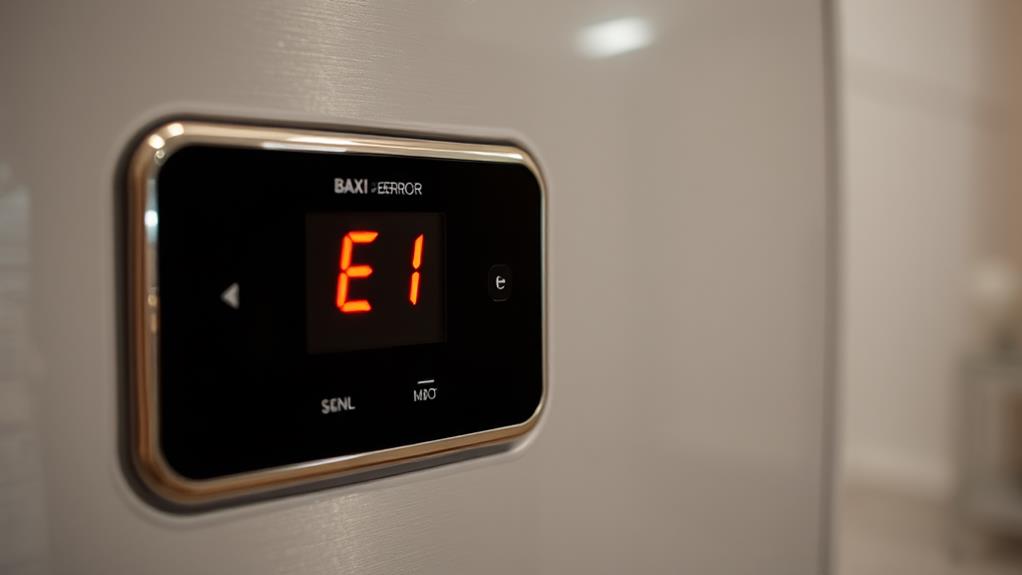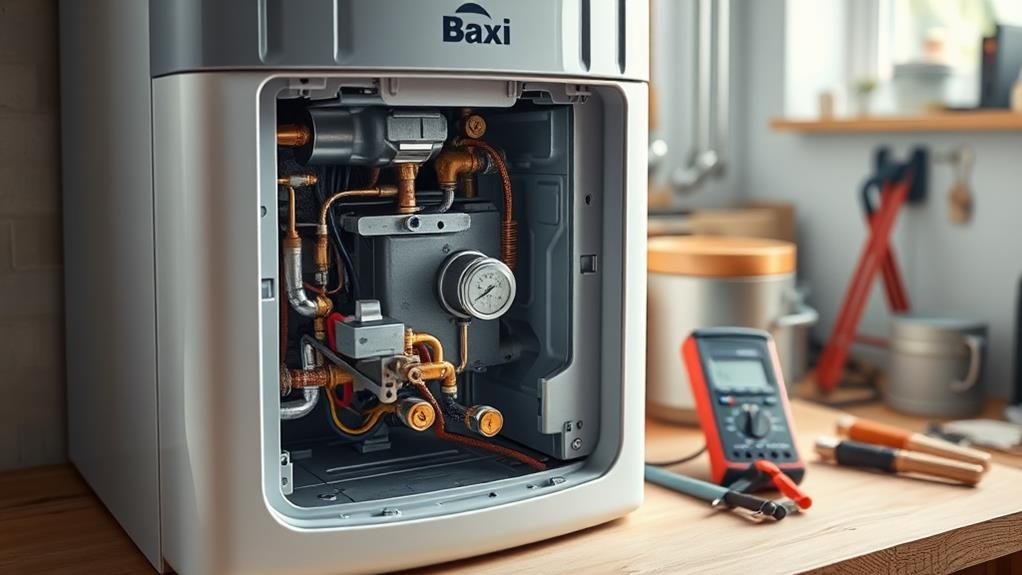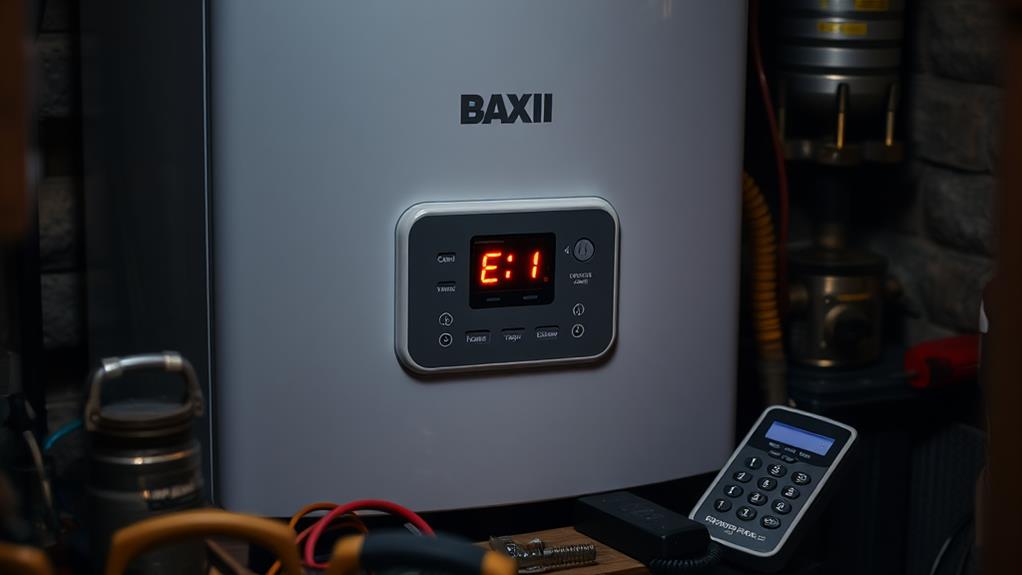If your Baxi Boiler displays the E20 error code, you’re facing an issue with the central heating sensor, which impacts water temperature monitoring. First, check the sensor connections for corrosion and verify wiring is intact. Use a multimeter to measure the sensor’s resistance and compare it against manufacturer specs. If readings fall outside expected ranges, consider sensor replacement. Confirm your boiler’s water pressure is within 1 to 1.5 bar, and inspect for sediment buildup in the heat exchanger. Resetting the boiler might clear the error, but persistent issues may require professional assistance. Delving deeper reveals strategies for prevention and resolution.
Key insights
- The E20 error code on a Baxi boiler indicates central heating sensor issues.
- Common causes include faulty components, low water pressure, or sediment buildup.
- Inspect and test the temperature sensor for damage or incorrect resistance readings.
- Resetting the boiler may clear the E20 error if issues are resolved.
- Persistent E20 errors after troubleshooting require professional technician assistance.
Understanding the E20 Error

Understanding the E20 error code involves a precise diagnosis of your Baxi boiler‘s functionality. When this code appears, it indicates a potential issue with the boiler’s central heating sensor or its associated systems. As per the Commercial Boiler Service London guide, these systems play an vital role in maintaining a comfortable environment in commercial spaces.
Your task is to approach the situation with a methodical mindset, focusing on boiler maintenance and system integrity. Regular maintenance, as advised by professionals, is essential in preventing unexpected breakdowns and associated costs. To start, make certain the boiler is turned off and cooled down before performing any checks.
The E20 error code typically necessitates inspecting the central heating sensor. This component measures the water temperature and relays this information to the boiler’s control system. If it’s malfunctioning, it can disrupt the boiler’s ability to regulate heat efficiently.
Next, you should verify that all wiring connections to the sensor are secure and free of corrosion or damage. Loose or corroded connections can lead to erroneous readings, triggering the error code. Engage in a visual inspection to make certain no visible signs of wear or damage.
Additionally, check the boiler’s user manual for any specific instructions related to the E20 code. This document often provides valuable troubleshooting steps tailored to your model, aiding in efficient problem identification and resolution. With careful inspection and maintenance, you’ll effectively manage and resolve this issue.
Common Causes of E20 Code
When diagnosing the E20 error code on a Baxi boiler, several common causes need your attention to guarantee efficient problem-solving. A primary culprit can be faulty components within the system. Start by inspecting the boiler’s pump for any blockages or signs of wear, as impaired circulation can trigger the E20 code. Additionally, examine the wiring and connections for any loose or damaged segments, which might disrupt the electrical flow necessary for proper operation.
System maintenance, such as regular inspections and checks by Gas Safe registered engineers, plays an essential role in preventing and identifying the causes of the E20 error code. Regularly scheduled maintenance checks should include thorough cleaning of the heat exchanger and verifying that all safety valves are functioning as intended. Sediment or scale buildup can obstruct water flow and affect boiler efficiency, prompting error codes.
Furthermore, the pressure within the system is critical; low water pressure can lead to an E20 error. Verify that the pressure gauge reads within the recommended range, typically between 1 and 1.5 bar. If it’s outside this range, adjust accordingly by bleeding radiators or refilling the system. By systematically addressing these potential issues, you’ll guarantee your Baxi boiler operates smoothly and efficiently, contributing to energy efficiency and cost reduction.
Checking the Temperature Sensor

To address the Baxi boiler E20 error code, it’s vital to carry out regular plant room maintenance to guarantee ideal operation and prevent such errors. Start by inspecting the temperature sensor connections, making sure they’re secure and free of corrosion. This process is a significant part of the preventative maintenance that helps in identifying potential issues early on. Next, test the sensor’s functionality using a multimeter to check for correct resistance values as specified in the manual. If the readings are outside the expected range, consider replacing the sensor to restore proper boiler operation.
Inspect Sensor Connections
The temperature sensor in your Baxi boiler plays an essential role in monitoring and regulating the system’s heat levels, and any loose or faulty connections can trigger the E20 error code. To guarantee peak sensor maintenance, first, power off the boiler to prevent electrical hazards. Locate the temperature sensor, typically found near the heat exchanger. Inspect the connection integrity by examining the wiring and connectors for any signs of damage, corrosion, or loose fittings. Ascertain that all connections are secure and intact, as a compromised link can lead to inaccurate readings and system malfunction.
Begin by gently disconnecting the sensor wiring to inspect the terminals for corrosion. Use a multimeter to check for continuity, confirming the wires are conducting electricity properly. Clean any corrosion with an appropriate electrical contact cleaner, and reattach the connectors tightly to maintain a stable connection. Pay close attention to the surrounding components for any signs of wear or degradation that might affect the sensor’s performance.
Test Sensor Functionality
Start by verifying the temperature sensor’s functionality to confirm your Baxi boiler operates efficiently. First, verify the sensor calibration is correct. Inaccurate calibration can lead to erroneous temperature readings, causing the E20 error code. Use a multimeter to perform functionality testing by measuring the resistance of the temperature sensor. Locate the sensor within the boiler system, usually near the heat exchanger, and disconnect it carefully to avoid damage.
Set your multimeter to the resistance mode (ohms) and connect the probes to the sensor’s terminals. Cross-reference the resistance readings with the manufacturer’s specifications, often found in the boiler’s manual. If the resistance deviates notably from the expected values, recalibrate the sensor or consider replacing it. Accurate calibration confirms that the boiler interprets temperature data correctly, preventing potential system malfunctions.
Next, inspect the sensor for physical damage, such as corrosion or broken wires, which could impair its performance. If no visible issues exist, reconnect the sensor and reset the boiler. Monitor for any recurring error codes. If the E20 error persists, it might be indicative of further internal issues requiring professional diagnostics. Always prioritize safety and consult a certified technician if you’re uncertain.
Resetting Your Baxi Boiler
When dealing with a Baxi boiler, particularly one displaying an E20 error code, it’s essential to follow the manufacturer’s instructions for a safe reset. Baxi, known for its high efficiency and renewable energy solutions, provides these guidelines to guarantee peak function of their boilers. To reset your Baxi boiler, first locate the reset button, which is typically found on the control panel. Press and hold the button as per the manufacturer’s instructions to initiate the reset procedure. Once completed, verify the boiler’s functionality by checking if the E20 error code has cleared and the system operates normally.
Locate Reset Button
When troubleshooting a Baxi boiler with an E20 error code, understanding how to locate and use the reset button is vital for resolving the issue effectively. The reset button location can vary depending on your specific Baxi model, but it’s typically found on the boiler’s front panel. This button is essential for restoring normal operations after addressing any underlying issues causing the error.
Follow these steps to accurately identify and comprehend its function:
- Identify the reset button: Look for a small, often red or orange button on the control panel. It might be labeled “RESET” or feature a circular arrow symbol.
- Consult the user manual: If you’re uncertain about the reset button location, refer to your boiler’s manual for a detailed diagram and instructions specific to your model.
- Understand the reset button function: The button resets the boiler’s internal controls, allowing it to restart sequences and clear temporary faults.
- Check for visible errors: Before pressing, verify that no other visible issues persist, which could cause the E20 error to reoccur.
Follow Reset Procedure
Getting your Baxi boiler back on track involves following a precise reset procedure that guarantees all systems are functioning correctly. To start, verify the boiler is powered off to prevent any electrical mishaps. This step is vital for a safe reset. Next, consult the troubleshooting checklist to confirm that all preliminary checks, such as gas supply and water pressure, are within the required parameters. These checks are fundamental for diagnosing issues that could hinder a successful reset.
Once your preliminary checks are complete, locate the reset button, which is typically found on the front panel. Firmly press and hold the button for about 5 to 10 seconds until you see the reset indicator light flash. This signals that the reset process has initiated. Release the button and allow the boiler to reboot. Follow these reset procedure tips carefully to avoid further complications.
Upon completion, listen for the boiler to reignite. If it doesn’t, revisit the troubleshooting checklist to identify any overlooked issues. Do not repeat the reset process multiple times as this may exacerbate underlying problems. If the error persists, professional assistance might be necessary to prevent further damage.
Verify Boiler Functionality
Verifying your Baxi boiler is functioning correctly after a reset is vital to maintaining a warm and safe home environment. Post-reset, it’s important to confirm that the boiler operates efficiently and consistently. Here’s a systematic approach to validate proper functionality using essential boiler maintenance tips and troubleshooting techniques:
- Check the Display Panel: Once reset, the display should show normal operation codes. If the E20 error code persists, additional troubleshooting techniques are necessary. Confirm there are no flashing or error indicators.
- Inspect Temperature Settings: Validate that the thermostat settings are accurate and responsive. Adjust the desired temperature and see if the boiler responds promptly, indicating proper communication between the thermostat and the boiler.
- Listen for Unusual Sounds: During operation, listen closely for any atypical noises such as banging or whistling. These could indicate underlying issues that require professional attention.
- Assess Water Pressure: The pressure gauge should read between 1.0 and 2.0 bar. Low or high pressure can lead to inefficiency or further errors. Adjust as needed according to the manufacturer’s guidelines.
When to Call a Professional

Faced with a persistent E20 error code on your Baxi boiler, it’s vital to know when professional intervention is necessary. While some issues can be troubleshooted independently, there are specific situations where seeking professional assistance is imperative. For instance, if you’ve verified the boiler’s functionality and the error persists, it’s time to reach out. Complex problems affecting the boiler’s pressure sensor or circuit board require an expert’s touch due to the intricate nature of these components. It’s worth remembering that these experts are often Gas Safe registered engineers, as is legally required for anyone servicing gas appliances in the UK.
Consider maintenance recommendations from Baxi, which emphasize the importance of annual servicing by certified technicians. This proactive measure not only enhances efficiency but also identifies potential issues before they escalate into costly repairs. If your boiler hasn’t undergone recent servicing, and the E20 error code remains unresolved, professional help is warranted.
In emergency situations, such as complete heating failure during winter, immediate professional support is vital. Always have emergency contacts for local, certified Baxi technicians readily available. These experts possess the necessary tools and expertise to diagnose and fix the problem swiftly, minimizing downtime and ensuring your home remains warm and comfortable. Remember, addressing the issue promptly can prevent further damage and costly repairs.
Preventing Future E20 Errors
Preventing future E20 errors on your Baxi boiler requires a proactive approach and attention to detail. Regular maintenance, including potential commercial power flushing, can greatly reduce the occurrence of this error code. Consistent monitoring of your system, coupled with professional power flushing, can also enhance the operational efficiency of your heating system. Implementing strategic boiler maintenance tips will help guarantee your heating system operates efficiently. Here’s how you can enhance error code prevention:
- Regularly Check Water Pressure: Monitor your boiler’s water pressure to guarantee it remains within the recommended range, typically between 1.0 and 1.5 bar. Low pressure can trigger the E20 error, so adjust as necessary using the filling loop.
- Inspect and Clean Sensors: Sensors can become obstructed by debris or limescale, leading to inaccurate readings and potential errors. Regularly clean and inspect these components to maintain peak performance.
- Schedule Annual Servicing: Engage a certified technician to conduct thorough annual servicing. This will help you identify potential issues early and guarantee all components, including the heat exchanger and pump, are functioning correctly.
- Bleed Radiators: Air trapped in radiators can disrupt system pressure and efficiency. Regularly bleeding your radiators will maintain effective heat distribution and system balance.
Frequently Asked Questions
How Long Does It Take to Fix an E20 Error on a Baxi Boiler?
When tackling an E20 error, you should first follow E20 troubleshooting tips. Check for issues like low water pressure or faulty sensors. By addressing these, you might resolve the problem quickly, within an hour. If you need professional help, E20 repair costs can vary, typically ranging from $50 to $150, depending on complexity. Always guarantee the system is off before repairs to avoid any safety hazards. Be proactive and efficient in problem-solving.
Can a Power Surge Cause the E20 Error Code on My Baxi Boiler?
“A stitch in time saves nine”—this holds true for boiler maintenance. A power surge can indeed trigger error codes, causing havoc with your Baxi boiler’s electronics. Understanding power surge effects is vital in boiler error troubleshooting. When a surge hits, it can disrupt the control system, leading to an E20 error. By using surge protectors and regularly checking connections, you can prevent these issues before they escalate.
Are Baxi Boilers Covered Under Warranty for the E20 Error Code?
When you’re dealing with an error code, it’s essential to check if your unit’s still under warranty coverage. Typically, warranties cover manufacturing defects, but specific error codes might not always be included. You’ll want to review the warranty details provided at purchase. Contact the manufacturer or your installer for clarity. They can confirm if your issue qualifies for repairs under warranty, ensuring you don’t face unexpected costs.
Is It Safe to Use My Baxi Boiler With the E20 Error Code Displayed?
When your boiler displays an error code, it’s essential to evaluate boiler safety. You shouldn’t use it until you’ve conducted proper error troubleshooting. An E20 code indicates a system issue that can affect performance. Start by checking the manual for guidance on resolving this error. If you’re unsure or the issue persists, contact a professional. Always prioritize safety over convenience to avoid potential hazards or further damage.
Do Other Boiler Brands Have a Similar Error Code to Baxi’s E20?
Like a detective solving a mystery, you’ll find that other boiler brands also have error codes similar to Baxi’s E20. Vaillant errors, Worcester Bosch errors, and Ideal boiler issues all have codes that demand attention. Error troubleshooting involves checking the manual or consulting a professional. Each brand has specific codes, so understanding them is vital for resolving issues efficiently and safely. Don’t ignore these alerts—they’re essential for maintaining peak boiler performance.
Summary
You’ve mastered the art of tackling the dreaded E20 error on your Baxi boiler. By diving into the labyrinth of common causes and deftly checking the temperature sensor, you’ve danced with the technical demons that plague your heating system. A quick reset might just be your magic wand, but remember, sometimes even wizards need a skilled sorcerer—aka a professional. With preventative measures, you’ll transform your boiler into an unyielding bastion against future malfunctions.

